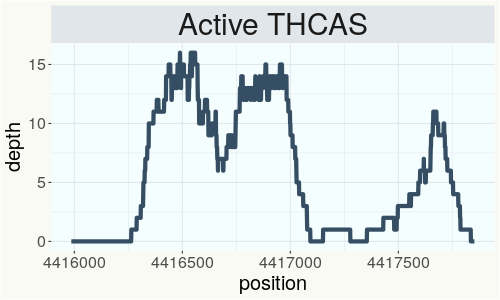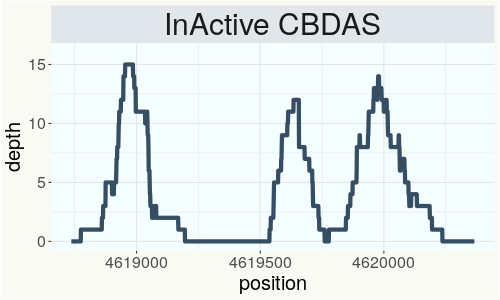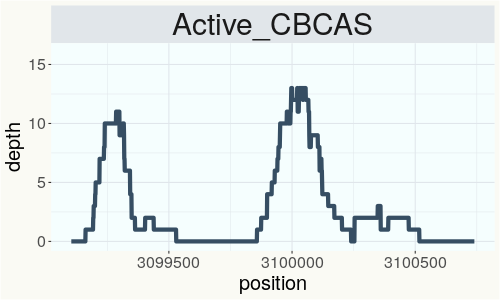Durban Poison #1
RSP 10996
Grower: DigiPath Labs
General Information
- Sample Name
- F20160801-04-15
- Accession Date
- August 28, 2017
- Reported Plant Sex
- Female
- Report Type
- StrainSEEK v2 3.2Mb
- DNA Extracted From
- Unknown
The strain rarity visualization shows how distant the strain is from the other cultivars in the Kannapedia database. The y-axis represents genetic distance, getting farther as you go up. The width of the visualization at any position along the y-axis shows how many strains there are in the database at that genetic distance. So, a common strain will have a more bottom-heavy shape, while uncommon and rare cultivars will have a visualization that is generally shifted towards the top.
Chemical Information
Cannabinoid and terpenoid information provided by the grower.
Cannabinoids
- THC + THCA
- 24.9%
- CBD + CBDA
- 0.056%
- THCV + THCVA
- 0.%
- CBC + CBCA
- 0.011%
- CBG + CBGA
- 1.031%
- CBN + CBNA
- 0.09%
Terpenoids
- α-Bisabolol
- 0.005%
- Borneol
- n/a
- Camphene
- 0.002%
- Carene
- 0.053%
- Caryophyllene oxide
- 0.004%
- β-Caryophyllene
- 0.099%
- Fenchol
- n/a
- Geraniol
- 0.016%
- α-Humulene
- 0.035%
- Limonene
- 0.071%
- Linalool
- 0.011%
- Myrcene
- 0.107%
- α-Phellandrene
- n/a
- Terpinolene
- 0.596%
- α-Terpineol
- n/a
- α-Terpinene
- 0.036%
- γ-Terpinene
- 0.71%
- Total Nerolidol
- 0.006%
- Total Ocimene
- 0.315%
- α-Pinene
- 0.049%
- β-Pinene
- 0.085%
Genetic Information
- Plant Type
- Type I
File Downloads
The bell curve in the heterozygosity visualization shows the distribution of heterozygosity levels for cannabis cultivars in the Kannapedia database. The green line shows where this particular strain fits within the distribution. Heterozygosity is associated with heterosis (aka hybrid vigor) but also leads to the production of more variable offspring. When plants have two genetically different parents, heterozygosity levels will be higher than if it has been inbred or backcrossed repeatedly.
The ratio of reads mapped to Y-contigs to reads mapped to the whole Cannabis genome (Y-ratios) has been demonstrated to be strongly correlated with plant sex typing. This plot shows the distribution of Y-ratios for all samples in our database which were sequenced with the same method (panel or WGS) as this sample and where this sample falls in the distribution.

This chart represents the Illumina sequence coverage over the Bt/Bd allele. These are the three regions in the cannabis genome that impact THCA, CBDA, CBGA production. Coverage over the Active CBDAS gene is highly correlated with Type II and Type III plants as described by Etienne de Meijer. Coverage over the THCA gene is highly correlated with Type I and Type II plants but is anti-correlated with Type III plants. Type I plants require coverage over the inactive CBDA loci and no coverage over the Active CBDA gene. Lack of coverage over the Active CBDA and Active THCA allele are presumed to be Type IV plants (CBGA dominant). While deletions of entire THCAS and CBDAS genes are the most common Bt:Bd alleles observed, it is possible to have plants with these genes where functional expression of the enzyme is disrupted by deactivating point mutations (Kojoma et al. 2006).



This chart represents the Illumina sequence coverage over the CBCA synthase gene.

Variants (THCAS, CBDAS, and CBCAS)
No variants to report
Variants (Select Genes of Interest)
Nearest genetic relatives (All Samples)
- 0.006 Durban Poison (RSP11226)
- 0.007 Durban Poison (RSP10998)
- 0.008 Durban Poison #1 (RSP11013)
- 0.011 Durban Poison (RSP11014)
- 0.114 Electra (RSP11366)
- 0.118 Lift (RSP11378)
- 0.120 Domnesia (RSP11184)
- 0.133 Black Jack (RSP10603)
- 0.137 BLACK JACK (RSP11346)
- 0.141 RKM-2018-025 (RSP11117)
- 0.142 RKM-2018-016 (RSP11108)
- 0.145 Doug s Varin (RSP11243)
- 0.147 Joy (RSP11380)
- 0.150 Serious Happiness (RSP10763)
- 0.157 Whitey (RSP11363)
- 0.159 Gold Cracker (RSP11048)
- 0.164 Trump x Trump (RSP11466)
- 0.165 Saint Jack (RSP11179)
- 0.168 Cheese (RSP10460)
- 0.169 UnObtanium (RSP11611)
Most genetically distant strains (All Samples)
- 0.415 80E (RSP11213)
- 0.410 Cherry Blossom (RSP11323)
- 0.386 80E (RSP11212)
- 0.386 80E (RSP11211)
- 0.377 CS (RSP11208)
- 0.372 Feral (RSP11205)
- 0.365 IUP3 (SRR14708256)
- 0.365 IUP2 (SRR14708257)
- 0.365 Tanao Sri -46- (RSP11486)
- 0.363 Cherry Blossom (RSP11314)
- 0.362 R1in136 (SRR14708227)
- 0.361 Feral (RSP11206)
- 0.359 R1in136 (SRR14708226)
- 0.359 R1in136 (SRR14708237)
- 0.357 Feral (RSP10891)
- 0.357 Cherry Blossom (RSP11306)
- 0.354 XBL1 (SRR14708207)
- 0.354 Chem 91 (RSP11185)
- 0.354 IUP1 (SRR14708258)
- 0.354 Carmaleonte (RSP11207)
Nearest genetic relative in Phylos dataset
- Overlapping SNPs:
- 60
- Concordance:
- 58
Nearest genetic relative in Lynch dataset
- Overlapping SNPs:
- 10
- Concordance:
- 10
Blockchain Registration Information
- Transaction ID
-
6425bcade14b86f1
5c102780907b4d64 cae20464712777a7 5d7bb67ca13fb9dd - Stamping Certificate
- Download PDF (834.5 KB)
- SHASUM Hash
-
48e405783986faf9a8ef1f770e830ea7 1089cf29fd7f0235 7cb3bde5c4f0d28a